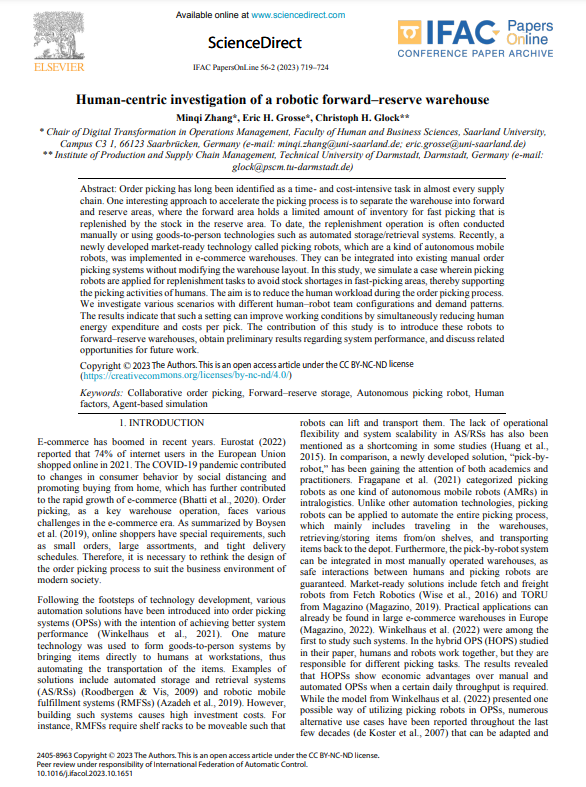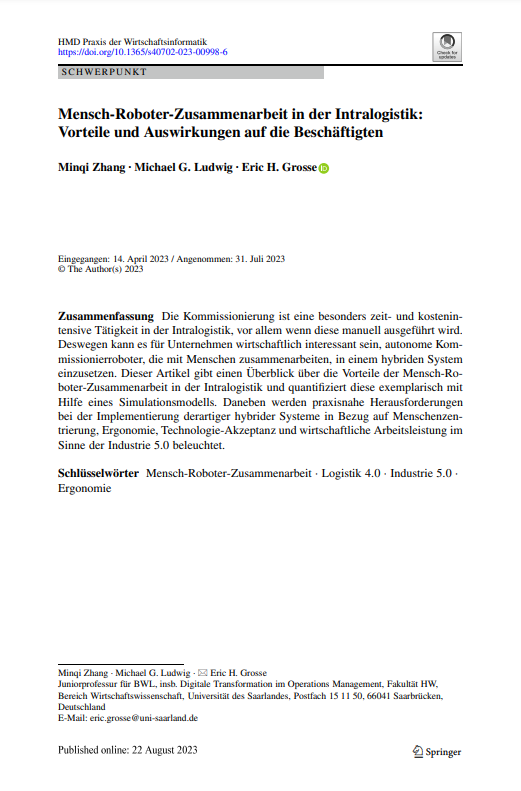Logistics 4.0
Kurzbeschreibung
The requirements of mass customization are nowadays addressed with digital technologies, such as the internet of things or cyber-physical systems leading to smart factories – also called Industry 4.0. These emerging technologies have gradually gained maturity leading to a technology push, driven by new customer demands. However, this operations system fails if the logistics link between companies and from companies to customers is fragile, putting competitive advantages at risk. Thus, besides Industry 4.0 in manufacturing, a digital transformation of logistics is needed, leading to Logistics 4.0.
Our research projects on Logistics 4.0 aim on developing this emerging research stream and on giving guidelines and ideas for future research to support the development of sustainable logistics systems.
Publikationen

Human-centric investigation of a robotic forward–reserve warehouse
Zhang, Grosse & Glock (2023)
Order picking has long been identified as a time- and cost-intensive task in almost every supply chain. One interesting approach to accelerate the picking process is to separate the warehouse into forward and reserve areas, where the forward area holds a limited amount of inventory for fast picking that is replenished by the stock in the reserve area. To date, the replenishment operation is often conducted manually or using goods-to-person technologies such as automated storage/retrieval systems. Recently, a newly developed market-ready technology called picking robots, which are a kind of autonomous mobile robots, was implemented in e-commerce warehouses. They can be integrated into existing manual order picking systems without modifying the warehouse layout. In this study, we simulate a case wherein picking robots are applied for replenishment tasks to avoid stock shortages in fast-picking areas, thereby supporting the picking activities of humans. The aim is to reduce the human workload during the order picking process. We investigate various scenarios with different human–robot team configurations and demand patterns. The results indicate that such a setting can improve working conditions by simultaneously reducing human energy expenditure and costs per pick. The contribution of this study is to introduce these robots to forward–reserve warehouses, obtain preliminary regarding system performance, and discuss related opportunities for future work.

Ergonomic and economic evaluation of a collaborative hybrid order picking system
Zhang, Grosse & Glock (2023)
Warehouses are important nodes in almost every supply chain. Within warehouses, order picking is a crucial task that is extremely time- and cost-intensive. While order picking systems (OPSs) have traditionally been operated manually, new technologies offer opportunities for reducing the workload of warehouse workers. These technologies include autonomous picking robots that can function in combination with human pickers within a shared workspace. This technology enables human–robot collaboration and enhances flexibility in system design, as robots can either support humans or work independently. Research on the advantages of these hybrid OPSs (HOPSs) for improving operational performance is still scarce, however. To contribute to closing this research gap, we propose an agent-based simulation model to investigate how HOPSs reduce the daily workload of human order pickers. The results reveal that HOPSs – if certain assignment rules for the picking tasks are considered – can reduce both the operational costs of the system and human workload compared to a pure manual or a fully automated OPS. Nonetheless, attention should be paid to control the item weight pickers are supposed to handle, as HOPSs reduce the travel distance of human pickers, resulting in a higher frequency of picking activities and an increased ergonomic risk for musculoskeletal disorders.

Mensch-Roboter-Zusammenarbeit in der Intralogistik: Vorteile und Auswirkungen auf die Beschäftigten
Zhang, Ludwig & Grosse (2023)
Die Kommissionierung ist eine besonders zeit- und kostenintensive Tätigkeit in der Intralogistik, vor allem wenn diese manuell ausgeführt wird. Deswegen kann es für Unternehmen wirtschaftlich interessant sein, autonome Kommissionierroboter, die mit Menschen zusammenarbeiten, in einem hybriden System einzusetzen. Dieser Artikel gibt einen Überblick über die Vorteile der Mensch-Roboter-Zusammenarbeit in der Intralogistik und quantifiziert diese exemplarisch mit Hilfe eines Simulationsmodells. Daneben werden praxisnahe Herausforderungen bei der Implementierung derartiger hybrider Systeme in Bezug auf Menschenzentrierung, Ergonomie, Technologie-Akzeptanz und wirtschaftliche Arbeitsleistung im Sinne der Industrie 5.0 beleuchtet.
Supply chain resilience: a tertiary study
Hägele, Grosse & Ivanov (2023)
International Journal of Integrated Supply Management
This tertiary study systematically analyzes 65 literature reviews on supply chain resilience (SCR) published in academic journals or conference proceedings. Our focus is on the vulnerabilities and capabilities of a supply chain that need to be balanced to achieve resilience. We explore the interdependencies of these two categories of SCR by developing an innovative framework to realize capabilities after identifying the SCR vulnerabilities. First, we propose a framework that systematizes the vulnerabilities and capabilities identified in the literature. Then, we discuss the identified SCR characteristics based on the framework and quantitatively evaluate the literature reviews’ focus on the two SCR categories. A synthesis of the research results shows the SCR characteristics addressed in the literature and reveals deficits for specific vulnerabilities. Finally, we outline future research opportunities based on these findings by mapping SCR capabilities and vulnerabilities in light of Industry 4.0 and digital supply chain developments. Then, we derive research gaps and recommended actions for practitioners in the context of SCR and Industry 4.0.
Logistik 4.0: Stand der Forschung und Praxis
Grosse (2022)
HMD Praxis der Wirtschaftsinformatik
Viele Unternehmen stehen aktuell vor großen Herausforderungen aufgrund hoher Kundenansprüche für individualisierte Produkte, aber auch aufgrund des Fachkräftemangels, des demographischen Wandels, volatiler Lieferantenmärkte, der Auswirkungen auf die Versorgungssicherheit ausgelöst durch Krisen wie die Corona-Pandemie sowie hohe Energiepreise und Rohstoffknappheit. Die Transformation zur Logistik 4.0 wird hierbei oftmals als Möglichkeit genannt, die Herausforderungen in den Griff zu bekommen und verspricht einen entscheidenden Wettbewerbsvorteil. Der Forschungsstrang ist jedoch noch relativ jung und für viele Entscheider in der Praxis ist noch unklar, was sich hinter dem Begriff Logistik 4.0 konkret verbirgt und welche Chancen daraus für Unternehmen entstehen können. Daneben gibt es viele Barrieren, die Transformationsprozesse scheitern lassen. Dieser Artikel gibt einen Überblick über den Stand der Forschung zur Logistik 4.0 und diskutiert Implikationen für die Praxis für einen nachhaltig erfolgreichen Transformationsprozess.
Drohnen in der Intralogistik - Chancen und Barrieren
Spurk, Grosse, Schnellbächer & Glock (2022)
Zeitschrift für wirtschaftlichen Fabrikbetrieb117(7-8)
Die Innovationsfähigkeit von Unternehmen bestimmt deren Wettbewerbsfähigkeit und wirtschaftlichen Erfolg. Dies trifft insbesondere auf innerbetriebliche logistische Prozesse zu, die einen direkten Einfluss auf Durchlaufzeiten und Kundenzufriedenheit haben. Innovationen im Rahmen einer „Logistik 4.0“ versprechen Prozessverbesserungen durch Automatisierung und durch die technische Unterstützung des Menschen bei manuellen Tätigkeiten. Eine dieser vielversprechenden Technologien sind unbemannte Luftfahrzeuge (Drohnen). Der vorliegende Beitrag konsolidiert den Stand der Forschung zu flugfähigen Drohnen in der Intralogistik und untersucht Potenziale und Barrieren. Es zeigt sich, dass grundlegende Veränderungen der Intralogistik durch Drohnen bislang ausgeblieben sind. Drohnen weisen aber vielfältige Potenziale auf, insbesondere in der Automatisierung spezifischer intralogistischer Prozesse, vor allem hinsichtlich der innerbetrieblichen Lieferung eiliger Güter und der Inventur, aber auch der Inspektion von Fertigungsanlagen.
Smart warehouses - a sociotechnical perspective
Winkelhaus & Grosse (2022)
The Digital Supply Chain
In this chapter, we discuss the smart warehouse concept and the challenges it entails with the increasing digitalization of the supply chain. The principal enabling technologies that play a major role in the progression towards smart warehouses are identified and discussed in the context of the changes occurring across business, industry, and the retail economy. The warehouse processes affected and potential influences of the technologies on warehouse management and operations are described. The chapter focuses on one of the most important process steps in the smart warehouse, order-picking, which is currently subject to major developments and transformations. Using a technological grid, four types of order-picking system are derived, which systematize how technologies can support human operators in warehouses to reduce physical workload and/or improve cognitive ergonomics. The four system types are classified based on supportive (digital) and substitutive (automation) technologies. The impacts of increased digitalization in warehouses on the physical, cognitive, perceptual and psychosocial human factors are examined from a sociotechnical perspective. These manifold influences are exemplified for the case of a collaborative order-picking system and broken down using an analysis framework that can be used for the systematic development of sociotechnical systems in the digitalisation of the supply chain.
Hybrid order picking: A simulation model of a joint manual and autonomous order picking system
Winkelhaus, Zhang, Grosse & Glock (2022)
Computers & Industrial Engineering 167(4)
Order picking is a key process in supply chains and a determinant of business success in many industries. Order picking is still performed manually by human operators in most companies; however, there are also increasingly more technologies available to automate order picking processes or to support human order pickers. One concept that has not attracted much research attention so far is hybrid order picking where automated and autonomous robots and human order pickers work together in warehouses within a shared workspace for a joint target. This study presents a simulation model that considers various system characteristics and parameters of hybrid order picking systems, such as picker blocking, to evaluate the performance of such systems. Our results show that hybrid order picking is generally capable of improving pure manual or automated order picking operations in terms of throughput and total costs. Based on the simulation results, promising future research potentials are discussed.
Job satisfaction: An explorative study on work characteristics changes of employees in Intralogistics 4.0
Winkelhaus, Grosse & Glock (2022)
Journal of Business Logistics
The increasing trend toward digitalization in logistics poses a significant managerial challenge, particularly by fundamentally changing the traditional, manual workplaces in intralogistics. Although intralogistics processes have, in some cases, already been automated or are supported by smart technologies, humans remain an inevitable part of future intralogistics but with changing work characteristics. This study aims to examine the influences of the transition toward Intralogistics 4.0 on work characteristics of intralogistics employees. First, a systematic literature review on work characteristics and job satisfaction in a broader Logistics 4.0 context was conducted. Thereafter, a qualitative, explorative methodology was employed to examine the perception of work characteristics that impact job outcomes such as job satisfaction, motivation, and performance at different Intralogistics 4.0 maturity levels. The results of semi‐structured interviews conducted across seven companies demonstrated the significant, heterogeneous changes of work characteristics related to the type of technology applied in Intralogistics 4.0. Our findings indicate that the development toward Intralogistics 4.0‐implemented workplaces does not have a simple or predefined impact on humans; instead, the individual design is relevant and can improve the workplaces with more opportunities for satisfying and motivating jobs.
Towards a conceptualisation of Order Picking 4.0
Winkelhaus, Grosse & Morana (2021)
Computers & Industrial Engineering 159(1)
Order picking is a key task in almost all supply chains and has a significant effect on operational efficiency of warehouses. Although most companies still rely on manual order picking, research on diverse possibilities to automate order picking tasks or support human order pickers with technology is increasing rapidly. This paper conceptualises Order Picking 4.0 (OP 4.0), considering substitutive and supportive technologies. Based on a conceptual background, a framework for OP 4.0 as a sociotechnical system is developed. A systematic literature review is performed to assess the state of knowledge in this field, and prospective research opportunities in OP 4.0 are highlighted.
Evaluation of Human Workload in a Hybrid Order Picking System
Zhang, Winkelhaus & Grosse (2021)
17th IFAC Symposium on Information Control Problems in Manufacturing
Order picking is a labor-intensive and costly process in supply chains, which is performed manually in most cases. Recently, picking robots have been developed which are capable of working together with human pickers in a shared working space. Such hybrid order picking system can ease human pickers’ workload and provide ergonomic improvements, because it partially automates the order picking process. We propose a simulation model to measure the energy expenditure of human pickers who work with the support of picking robots. The hybrid order picking system is evaluated based on its operational costs, efficiency, and ergonomic characteristics. Preliminary results presented in this study show that there are assignment rules for items to workers and robots that reduce human energy expenditure and costs per pick, as well as maintain average throughput time at a certain level. The aim of this preliminary study is to closely analyze the hybrid order picking system, evaluate managerial implications, and detect research opportunities for future works.
Mensch-Roboter-Kollaboration in der Kommissionierung
Zhang, Semar, Grosse, Winkelhaus & Glock (2021)
ZWF Zeitschrift fuer Wirtschaftlichen Fabrikbetrieb 116(6)
Die Kommissionierung weist in den meisten Unternehmen einen hohen Anteil an manueller Arbeit auf und ist sehr zeit- und kostenintensiv sowie fehleranfällig. Um diesen Prozess zu automatisieren, wurden autonome Roboter entwickelt. Eine modularisierte Lösung stellt die kollaborative Kommissionierung dar, welche die Vorteile der manuellen und robotergestützten Kommissionierung kombiniert. Dieser Beitrag systematisiert die kollaborative Kommissionierung und entwickelt ein Simulationsmodell, um deren Potenziale herauszustellen.
Work characteristics in Logistics 4.0: Conceptualization of a qualitative assessment in order picking
Winkelhaus & Grosse (2020)
21st IFAC World Congress 2020
Logistics 4.0 is an emerging phenomenon, where new digital technologies are used to fulfil increasing demands of delivering individualized products against high cost pressure and fast delivery times. Within this development, human factors should not be neglected, since they will remain an important aspect of process efficiency and business success. One logistics process that has undergone a major transformation within Logistics 4.0 regarding manual human work is warehouse order picking. However, the implications of increasing digitalization on human workers in order picking are not yet fully understood. Hence, this contribution grounds on a qualitative assessment of work characteristics in order picking and conceptualizes possible influences of the digital transformation on order pickers. These conceptual interrelations enable to design future workplaces that allow higher job satisfaction, motivation, quality and performance of work as well as lower turnover intentions.
Digitale Verzahnung in variantenreicher Fertigung - Komplexe Produktions- und Logistikprozesse mittels mobiler Apps harmonisieren
Winkelhaus, Grosse & Bauer (2020)
Industrie 4.0 Management 36(4)
The paradigm shift towards a customer focused mass customization in Industry 4.0 and corresponding Logistics 4.0 requires technical solutions to make these approaches economically viable. When human workers on the shopfl oor are faced with these technologies, however, they can be the source of fear and resistance. Applications for mobile devices are a user-friendly component of a digitization strategy in this light. A real life example from the printing industry is highlighting how apps can be used to save money, improve process reliability and increase worker satisfaction at the same time.
Logistics 4.0: a systematic review towards a new logistics system
Winkelhaus & Grosse (2020)
International Journal of Production Research 58(1)
Enterprises are confronted with new customer requirements and challenged by global competition leading to fundamental changes of today’s industry. Against this background, at present Industry 4.0 is the main concept of dealing with these challenges in manufacturing. Lacking a comparable covering concept in logistics, this study aims to stringently unify diverse approaches in research to a Logistics 4.0-framework in order to generate a new picture of the state of logistics research. In this article, a comprehensive framework of Logistics 4.0 is developed. First, the term Logistics 4.0 is defined, and then a systematic literature review of 114 articles on Logistics 4.0 is performed. The resulting framework combines external triggers, main technological innovations, impacts of human interactions and logistics tasks. Existing solutions that support Logistics 4.0 are summarised according to the technologies: internet of things, cyber-physical systems, Big Data, cloud computing, mobile-based systems, social media-based systems and further technologies. Managerial implications are outlined and open research issues are examined. For researchers, this review offers the possibility to unify and expand existing solutions and to identify links and interfaces that are still needed. As for managerial implications, this framework can be used to identify future strategies and technologies to fulfil certain logistics tasks, but also to develop new technological solutions for current and future demands.
Logistik 4.0 – Paradigmenwandel als Chance für Menschen und Unternehmen
Winkelhaus & Grosse (2019)
ZWF Zeitschrift fuer Wirtschaftlichen Fabrikbetrieb 114(10)
Die vierte industrielle Revolution verändert über die Produktion hinaus weite Teile des wirtschaftlichen und gesellschaftlichen Handelns. Die Logistik sieht sich durch den Paradigmenwechsel hin zur kundenindividuellen Massenfertigung vor einem Wandel zur Logistik 4.0, in der mittels technischer Innovationen nachhaltig und effizient individuelle Anforderungen erfüllt werden. In diesem Beitrag werden Logistik 4.0 definiert und die Rolle des Menschen darin näher beleuchtet.
On the Way to Logistics 4.0 - a Systematic Review and Outlook
Winkelhaus & Grosse (2019)
9th IFAC Conference on Manufacturing Modelling, Management and Control (MIM 2019)
Kurzbeschreibung
Warehousing 4.0 - Technische Lösungen und Managementkonzepte für die Lagerlogistik der Zukunft
Glock & Grosse (2017)
Die Lagerlogistik befindet sich im Umbruch. Neue Möglichkeiten, die sich durch das Voranschreiten von Industrie 4.0 ergeben, haben unlängst Einzug in die Intralogistik und deren Prozesse gehalten. Die Potenziale der Automatisierung, Digitalisierung und Datenintegration sowie innovativer Managementkonzepte eröffnen dabei bisher ungeahnte Chancen zur Optimierung innerbetrieblicher logistischer Prozesse. Interpretiert man diese Entwicklungen und zukünftige Möglichkeiten in einem breiten Kontext, so entsteht der Begriff Warehousing 4.0. Vor allem die bisher sehr stark von manuellen Tätigkeiten geprägte Lagerlogistik profitiert von diesen spannenden Entwicklungen. Wir erleben durch das Warehousing 4.0 jedoch nicht die Abschaffung der manuellen Arbeit im Lager – vielmehr wird die Arbeit der Mitarbeiterinnen und Mitarbeiter aufgewertet bzw. unterstützt und diese letztendlich entlastet. Fahrerlose Transportsysteme, die ganze Regale autonom zu den Mitarbeitern transportieren, Serviceroboter oder auch technische Assistenzsysteme, wie Datenbrillen oder Exoskelette, sind nur einige wenige Beispiele für die Möglichkeiten, die das Warehousing 4.0 Unternehmen eröffnet. Dieses Buch gibt zunächst einen Überblick über die Entwicklung der Industrie 4.0 und zeigt Potenziale auf, die sich daraus für die Lagerlogistik ergeben. Anschließend werden innovative technische Lösungen zur Automatisierung und Digitalisierung in der Lagerlogistik vorgestellt. Zudem wird aufgezeigt, wie der Mensch in der Lagerlogistik durch neue Managementkonzepte und Assistenzsysteme unterstützt werden kann. Schließlich beleuchten Best Practice-Beispiele die mögliche Umsetzung der vorgestellten Ansätze. Das Buch unterstützt dadurch vor allem Praktiker dabei, die Potenziale des Warehousing 4.0 bestmöglich kennenzulernen und umzusetzen. www.warehousing40.com









